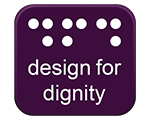Design For Dignity
Retail Guidelines




Getting to the checkout or payment desk and paying for your purchases is a routine that most people take for granted. The considerations for people with disability are more complex and are a critical factor in whether the person can shop independently and can purchase goods in the same way as others.
Getting assistance from employees can be a positive or a negative depending on how it's handled. Baker (2006)*Baker, S. M., 2006 Consumer Normalcy: Understanding the value of shopping through narratives of consumers with visual impairments, Journal of Retailing, 82 (1), pps 37-50. describes how providing unwanted assistance can reduce a person's sense of independence, yet can be critical in enabling the person to shop. The AND survey also found that getting the right assistance is about striking a balance, but the first principle is to ask the customer how you can help rather than taking control out of a customer's hands.
“Have staff readily available to assist those with a disability [during] the checkout process.”
“Some people look like they need assistance when in fact they don't so it's about striking a balance.”
Payment terminals pose challenges to customers in a number of areas, including instances where:
Cash payment can also pose difficulties. Consider a person who is blind who hands over $50 for an item in a store. The person is reliant on the assistant to correctly count back the notes and provide them in a way that the person can easily put away.
“EFTPOS machines are fixed and out of reach for those using a wheelchair.”
Having space at, and around, the counter allows people to bring goods to the counter and if necessary pass by the counter to get out of the store. In supermarkets, keeping dedicated wider aisles open and clear ensures that people using wheelchairs, mobility scooters and prams can easily do their shopping.
Survey respondents with physical disability felt that the counter height and space underneath was very important. The effective height of a counter is also increased when merchandise, computers and sales information is placed on top. It creates a very unequal customer experience with standing sales staff peering over the top and people approaching the counter at a lower level.
“Provide low height payment counters with leg room underneath or beside it for wheelchair users to be able to use from a seated position”